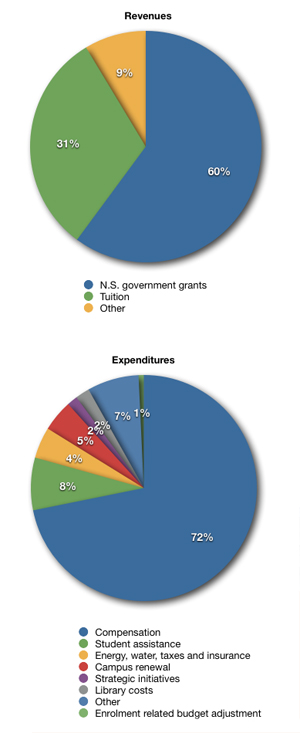 |
| The rounded breakdowns for where Dalhousie's money is expected to come from and be spent in 2010-11. |
The Dalhousie budget is balanced – but how thin a thread is it balanced on?
Tuesday, the Board of Governors passed a university operating budget for 2010-11 of $316 million. It includes increases in strategic initiatives funding and student assistance, made possible by higher revenues from both the provincial operating grant and from tuition fees due to increased enrolment. But it also sees many departments across the university facing small cuts in their base budgets.
Hanging over the budget – the elephant in the room – is the state of the university pension plan, which remains over $100 million in deficit. While the province has granted Dalhousie a one-year reprieve from a solvency test which would have forced immediate and dramatic payments to fill the hole, the university was unable to achieve consensus with its various employee groups to increase their contributions towards stabilizing the plan.
By making cuts or limiting increases for several budget items, the university was able to put together an extra $5 million to contribute to the pension fund this year. But the university administration made it clear to the Board that this is hardly a solution to the problem; it’s a stop-gap measure that merely delays some tough choices for future budgets.
“We are facing some real uncertainty in the next few years,” said Vice-President Academic Alan Shaver, who presented the budget to the Board along with Vice-President Finance and Administration Ken Burt.
Those uncertainties include the funding arrangement with the province – a new Memorandum of Understanding is to be negotiated this year – new contracts with nearly all of the university’s major employee groups, and the lack of consensus on a sustainable pension funding arrangement, a process that essentially grants each employee group a veto on any changes.
“We will have to continue discussions with our employee groups over the next year to get to a different arrangement,” said Mr. Burt on the latter subject.
As for the budget itself, it represents something of a turning point for the university. After a decade that saw most units’ funding increase steadily – in some sectors, like student services functions, by almost 100 per cent – the bulk of departments across the university will have slightly less to work with in their base budget in 2010-11, a sign that the next few years may bring more restraint. This will especially be the case if the new Memorandum of Understanding with the province ends up freezing or cutting post-secondary funding.
However, President Tom Traves made it clear to the Board that the budget is still designed to give Dalhousie the flexibility to address strategic priorities and expand areas of excellence. Like previous budgets, the 2010-11 budget reallocates money to the strategic initiative fund, this year a total of $9.3 million. Similar to last year, about half of that – $4.8 million – is earmarked for one-time use, meaning that the university will have that base amount in subsequent years. The remainder will be spent this year on projects to further the university’s strategic objectives. These include (among others):
- $693,000 for projects to improve student experience, including the project to revamp the university website, funding for career services and improved support for international students
- $1.8 million for campus renewal projects and facilities operations
- $369,000 for bursary and scholarship funding as well as enhanced recruitment and marketing
The budget also expands student assistance by $3.1 million. The bulk of this ($2.6 million) comes from the Government of Nova Scotia to expand the provincial bursary program – full-time students from Nova Scotia will receive $1,283 this year, while students from elsewhere in Canada will receive $261. In addition, Dalhousie is increasing operating budget support for student assistance by $184,000 and creating $343,000 in new scholarships and bursaries. That number is in addition to an increase of $560,000 in Faculty-based student assistance.
RELATED LINK: 2010-11 Dalhousie University Operating Budget (PDF)
